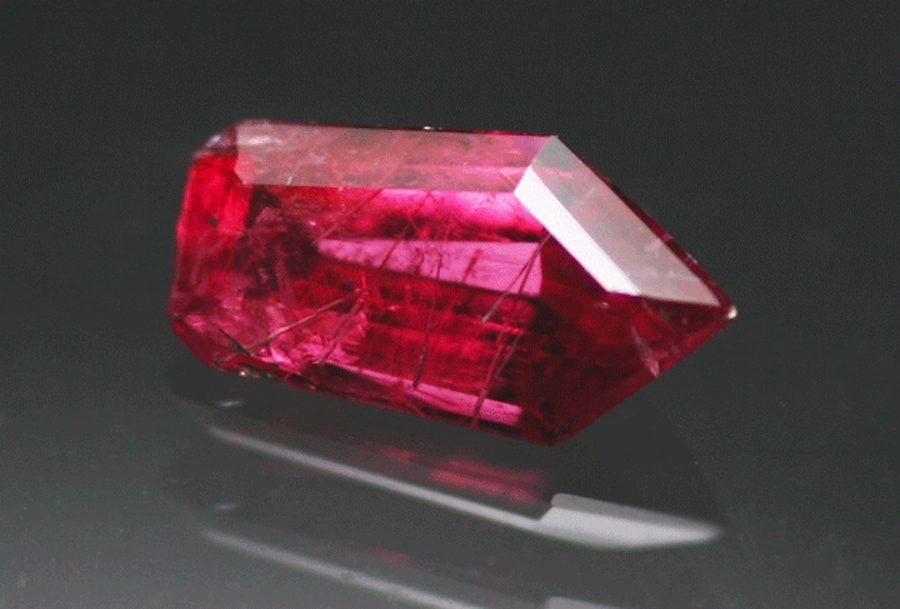Pyroxmangite Value, Price, and Jewelry Information
Pyroxmangite grains are rare, seldom clean enough to facet, and difficult to cut. However, when cut, they are extremely beautiful and rich in color.
1 Minute Read
Pyroxmangite grains are rare, seldom clean enough to facet, and difficult to cut. However, when cut, they are extremely beautiful and rich in color.
Start an IGS Membership today
for full access to our price guide (updated monthly).Pyroxmangite Value
What is Pyroxmangite?
Pyroxmangite forms a series with pyroxferroite. In pyroxferroites, the iron (Fe) content exceeds the manganese (Mn) content. (The pyroxmangite type material from South Carolina later proved to be pyroxferroite).
Pyroxmangites are also polymorphous with the popular gem material known as rhodonite, sharing the same chemical structure. Sometimes, they occur together.
Does Pyroxmangite Make a Good Jewelry Stone?
Although pyroxmangites can show stunning transparent red colors, from reddish brown to purplish pink, these rare gems have perfect cleavage in two directions. This makes them difficult for faceters to cut and means they have great susceptibility to fracture from blows, thus, you'll rarely see them used as jewelry stones. With a hardness (5.5 to 6), pyroxmangites are also susceptible to scratches. Protective settings for any jewelry use is recommended.
Identifying Pyroxmangites
Even professional gem labs may have difficulty distinguishing pyroxmangites from rhodonites. Although rhodonites may have slightly lower refractive index (RI), birefringence, and specific gravity (SG) values, these properties as well as their colors, pleochroism, optic character, and hardness may largely overlap. Sometimes, a powder X-ray diffraction (XRD) analysis may be needed.
Are There Synthetic Pyroxmangites?
Scientists have synthesized pyroxmangite to study its polymorphism with rhodonite. However, there is no known jewelry use for this synthetic material.
There are no known gem treatments for pyroxmangites.
Where is Pyroxmangite Found?
Honshu, Japan and Brazil have produced gemmy material. Other notable sources include the following:
- United States: Kern County, California; Colorado; Boise, Idaho (pale pink material).
- Australia: Broken Hill, New South Wales (in fine crystals and grains, with rhodonite).
- Finland (brown); Peru; Spain; Sweden (red-brown); Scotland, United Kingdom.
Stone Sizes
Any faceted pyroxmangites are always small, since the material is extremely scarce and available only as small transparent grains, but faceters can cut large cabochons from cleavages and massive materials. Collectors should expect to see stones up to about two carats.
Caring for Pyroxmangites
Due to their cleavage, don't clean pyroxmangites with mechanical systems such as ultrasonic or steam. Clean these gems only with a warm damp cloth, mild detergent, and soft brush. For more care recommendations, consult our gemstone jewelry cleaning guide.
Joel E. Arem, Ph.D., FGA
Dr. Joel E. Arem has more than 60 years of experience in the world of gems and minerals. After obtaining his Ph.D. in Mineralogy from Harvard University, he has published numerous books that are still among the most widely used references and guidebooks on crystals, gems and minerals in the world.
Co-founder and President of numerous organizations, Dr. Arem has enjoyed a lifelong career in mineralogy and gemology. He has been a Smithsonian scientist and Curator, a consultant to many well-known companies and institutions, and a prolific author and speaker. Although his main activities have been as a gem cutter and dealer, his focus has always been education. joelarem.com
International Gem Society
Related Articles
Black Diamond Value, Price, and Jewelry Information
Chameleon Diamond Value, Price, and Jewelry Information
Gray Diamond Value, Price, and Jewelry Information
Green Diamond Value, Price, and Jewelry Information
Latest Articles
Morganite Buying Guide
How Do Amethysts Form?
Rhodizite Value, Price, and Jewelry Information
Pearl Treatments and Enhancements
Never Stop Learning
When you join the IGS community, you get trusted diamond & gemstone information when you need it.
Get Gemology Insights
Get started with the International Gem Society’s free guide to gemstone identification. Join our weekly newsletter & get a free copy of the Gem ID Checklist!
